Intonation is a critical component of music making. Students must understand how to match the pitch center of others in unison passages, and how to relate their pitch center to the lowest voices in harmonic passages. Being able to hear whether they are sharp or flat is only helpful if students have a broader understanding of how intonation works. The most musical performances demonstrate a clear attention to the integrity of pitch center at all times.
Systems of Tuning
Prior to the late 16th century, many systems of tuning were in use, such as Pythagorean tuning and meantone temperament. The gradual acceptance of equal temperament radically changed the future of tuning systems. Equal temperament divided the octave into twelve equal half steps and finally allowed composers to write music that sounded suitable on fixed-pitch instruments in any key.
The two systems of tuning that are most relevant to music performance today are equal temperament and just intonation. Electronic tuners and all fixed-pitch instruments (mallet percussion, piano, harp, etc.) use equal temperament. The natural acoustics of sound, however, operate according to the overtone series, which forms the basis for just intonation. To help students understand this difference, I describe equal temperament as being like a ladder with 12 equal rungs, while the system of just intonation results in a ladder with rungs that are not spaced evenly or symmetrically. In an ensemble, then, equal temperament is frequently used to tune individual pitches, and just intonation is used to tune intervals in melodic passages and harmonic structures. Understanding these two systems will greatly improve a student’s ability to address intonation problems.
The Overtone Series
The overtone series results from sympathetic vibrations in the air when a given pitch is sounded. The first partial is referred to as the fundamental, which is the pitch that we hear. The overtones occur at regular intervals above the fundamental pitch according to the pattern at the top of the next page.
To help students understand this scientific phenomenon, I demonstrate the overtone series on a piano. Select a low note that will serve as the fundamental pitch. Lightly depress the piano key an octave higher with your right hand to release the hammer, but without sounding the pitch. While holding down this note, strike the fundamental pitch loudly with your left hand and immediately release the key. The upper octave will vibrate sympathetically.
Continue in the same fashion, depressing the next highest note in the overtone series each time with your right hand and then striking the fundamental pitch with your left hand. Depending upon how well in tune the piano is, some partials will sound louder than others. I can usually get all of the overtones to sound up to the 8th partial. Conversely, depressing the key of a note that is not in the overtone series will result in no sympathetic sound whatsoever.
You can also demonstrate the overtone series by playing any brass instrument for the class. Simply play every partial from the lowest note to the highest note for a given fingering. Brass instruments are built so that the fundamental pitch is typically a pedal tone, which is not always easy to produce. Explain to students that the first pitch of the overtone series on most brass instruments is actually the second partial.
String instruments are also great for demonstrating the overtone series. Natural harmonics can be produced by laying a finger over a given string at the correct interval. Instead of pushing the string against the fret board, gently touch the string at the appropriate node. For example, the first overtone of an octave occurs at exactly half the total length of the string. All of the overtones can be produced by dividing the string into smaller and smaller segments.
Unison Tuning
The characteristic color of each instrument is created by the relative presence or absence of harmonics from the overtone series. This is why tone and pitch center are so closely related. When tuning individual pitches, we align the fundamental frequency of a given pitch, which in turn, allows the sympathetic vibrations to align as well. When players match both the pitch and tone of their section, they have effectively strengthened the overtone series which results in a warm, vibrant sound. There is great truth to the adage, “To play in tune, one must play in tone.”
I use electronic tuners at the beginning of rehearsal for tuning notes and occasionally during rehearsal to help tune the root of a given chord. I have students hum the pitch first to internalize it and then open their mouths to sing the pitch on a neutral syllable such as lah or tah. Students using a tuner should only look at it after they have established a steady, full sound on their instrument. I always emphasize producing their best sound first. Students need to learn how to match pitch center using their ears, not their eyes.
When two pitches are not in tune, the unmatched wavelengths create nodes that sound as audible beats. The easiest way to teach students how to tune is to focus on eliminating these beats. As the beats get slower, the two pitches get closer to being in tune until eventually the beats disappear. It is easier to hear the beats on flute and saxophone, which makes them great for demonstration.
Matching the pitch center in unison passages must begin with the people sitting next to each other, so I have students work on partner tuning. Students simply practice eliminating beats with one other person at a time. In addition to matching the pitch of their neighbor, they must match their tone and volume as well. This contributes toward the development of good blend as well as pitch center. If every student fulfills this responsibility, then a web of listening is created across the entire ensemble.
By using this approach to tuning, it is initially unimportant whether students can tell if they are flat or sharp. This is an advanced skill that they can learn over time. As they get better at eliminating beats, I teach students to hear sharp pitches as being brighter and flat pitches as being dull. I encourage students to purposefully flatten their pitch or pinch it sharp so that they can physically feel the sensation in addition to hearing it.
Harmonic Tuning
When tuning intervals or triads, students must align their harmonies with the overtone series. Just like unison tuning, students will hear audible beats if the higher note is not aligned with the overtone series produced by the lower note. Because electronic tuners use equal temperament, only the fundamental pitch can be tuned with a tuner. The intervals must be tuned using just intonation. The differences between equal temperament and just intonation are summarized according to commonly used intervals in the table below.
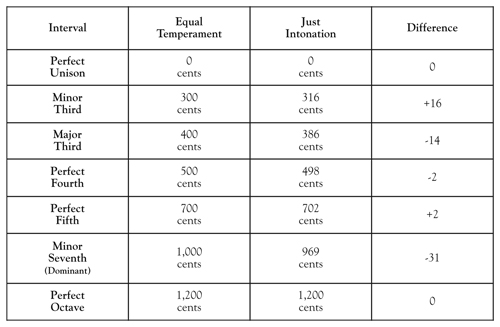
I use a variety of tuning exercises to help students hear intervals, and students first learn the adjustments needed to tune a perfect fifth (+2) and the major third (-14). These are the most common intervals that students will need to tune. I only introduce the number of cents needed to tune these intervals so students know the relative amount that the interval must be moved. Once students develop some proficiency at eliminating the beats on these internals, I add the minor third (+16) and dominant seventh (-31). Rather than memorize the number of cents, I ask students to commit to memory that a minor third should be played moderately sharp, a major third moderately flat, a perfect fifth slightly sharp, and a minor seventh very flat. I rarely have to spend rehearsal time on intervals beyond these as students quickly develop competency at tuning intervals by ear.
Cadences are the best place to start with harmonic tuning in ensemble literature. Any chord that is held for a longer duration will expose an ensemble’s ability to eliminate beats. Initially, the director should help students identify their chord tone. Be sure to have a plan ready when tuning chords since all of the transposition involved can be confusing for students. It is best to build chords in the following order: root, fifth, third, seventh. Do not add additional intervals until the pitches already sounding have locked. Have students sing their chord tone as well to help them internalize the pitch center. Over time students will develop the ability to identify what part of the chord they have by ear and adjust quickly to eliminate beats.
Pitch Tendencies
Directors should know the characteristic pitch tendencies for every instrument. Similarly, students should memorize the tendencies for their instrument. Regardless of the instrument manufacturer, there are inherent pitch problems that result from the natural acoustics of each instrument. For example, the 5th and 7th partials are naturally flat in the overtone series. Since brass instruments are based on overblowing the partials of a given fingering, students can always expect those partials to be out of tune.

I have students complete an intonation chart each year to check the natural pitch tendencies of their instrument. Students begin by using their best tuning note to tune their instrument. I use concert A for most of the woodwinds, Bb for the brass and clarinets, and F for the horns. I always encourage students to move up to their tuning note by playing a short series of notes, such as F-G-A-Bb. This prevents students from playing the tuning note off center. Trumpet players will often pinch their tuning note sharp if they start right on C. Similarly, flute players will unintentionally roll their instrument slightly in or out on their A. Walking up to the tuning note provides context and helps center the overall sound and pitch.
To complete the chart, students play a chromatic scale on whole notes through the full range of their instrument. I instruct them to play with a steady, pleasant sound at a mezzo forte dynamic. It is important that they not try to adjust the pitch, and each student completes the assignment with a partner who watches the tuner, so that the student performing is not unduly influenced by seeing the tuner. I encourage students to start with their tuning note and then descend by half steps to the bottom of their range. They then return to the tuning note and ascend to the top of the range. Once completed, the student keeps the intonation chart in his music folder for future reference.
It is also important for students to learn the common alternate fingerings and shadings for their instrument. Alternate fingerings can help increase technical facility in difficult passages and also improve intonation in sustained or exposed passages. Although it is possible for brass players to adjust pitches solely by using their embouchures, this approach decreases endurance considerably faster and also adversely affects the consistency of the tone. It is far better to use alternate fingerings when the option is there. For example, the following alternate fingerings can be used on trumpet as needed:
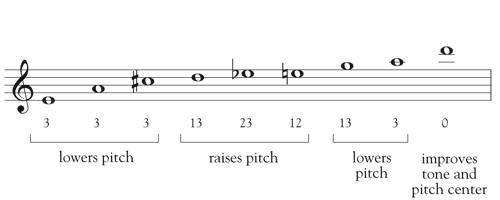
Shadings improve the stability of some notes on woodwind instruments, both in terms of tone color and pitch center. On clarinet, the throat tones vary widely in quality on every instrument. Teaching students to add the right-hand portion of the fingering for F3/C5 is a good starting point for shading and also helps them get over the break more quickly when approaching it from the throat tones.
.jpg)
Applications in the Literature
A director should become adept at identifying passages in the literature that may create intonation difficulties. In the opening of Incantation and Dance by John Barnes Chance, the entire flute section plays an unaccompanied melody in a low register, which is typically very flat. Every player has to adequately support the sound with a full, fast air stream to ensure that the opening is up to pitch. Otherwise, the clarinet entrance that follows will sound sharp in relation to the flutes, even if the clarinets enter at the correct pitch.
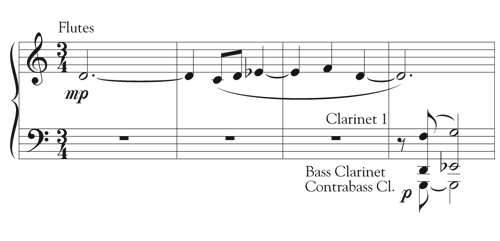
In Colonial Song by Percy Grainger, the trumpet soloist should lower the A naturals in the melody. This pitch is typically sharp on trumpet but is functioning as the third of the chord in this passage. The player can either use the first valve trigger to lower the standard 1-2 fingering or use the alternate fingering of third valve only. In addition, D5 is typically flat, so the soloist must adequately support the sound to bring it up to pitch.

A similar dilemma exists for the alto saxophone soloist in the first movement of the Holst First Suite in Eb. Both D and A are typically sharp on alto saxophone, but in this melody they are the tonic and fifth. The D will need to be lowered rather considerably and the A slightly. Both can be accomplished by lowering the jaw slightly. Additionally, the player should strive to hear the melody in his head before he plays it, adequately support his tone, and listen to the flute and oboe soloists to reach a consensus on pitch.

The challenges of adjusting intonation become more complex in harmonies. Each phrase in the opening section of Chester by William Schuman ends with a sustained cadential chord. The horns are playing D5, which is typically sharp, but is used as a major 3rd here. The third trumpets end their phrase on E4, which is also typically sharp, but is also the third of a major chord. The horns can lip down accordingly or use an alternate fingering, whereas the easiest solution for the trumpets is to use their first valve trigger. Have all players identify their chord tones as follows:
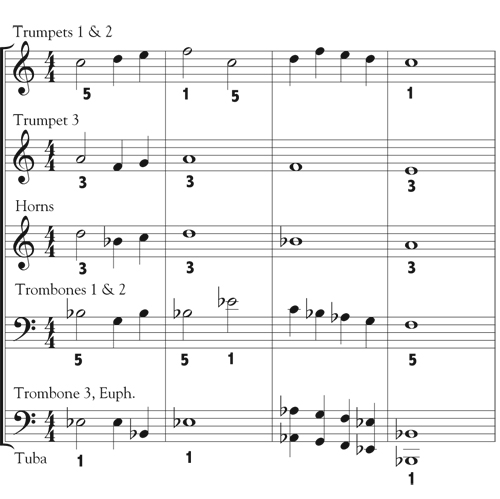
A similar example occurs just after the opening in Symphonic Dance No. 3 by Clifton Williams. This part calls for a three-part divisi in piccolos, flutes, and clarinets. The players on all second parts have the major third, which must be lowered to eliminate beats. The third clarinets are sustaining a throat tone A on the root of the chord, so it should be shaded accordingly. Lastly, there is a major seventh marked pianissimo that appears in muted trumpet only. This part usually gets lost in the texture due to the soft dynamic and the unusual dissonance that it creates with the major triad. The first trumpet should be encouraged to play stronger to be heard.
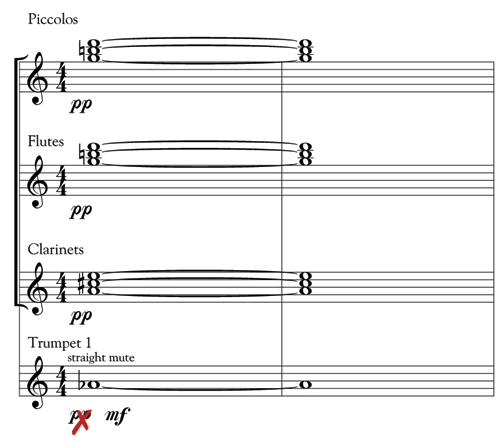
Grainger’s chorale setting of Irish Tune from County Derry tests an ensemble’s ability to play with beauty of phrasing and expression. It inherently requires great attention to pitch center throughout. For example, the low brass will have to tune carefully in the opening measures. The opening three pitches in trombone and euphonium sound a major third, perfect fourth, and perfect fifth against the pedal C, which the tubist on the lower octave should finger with the fourth valve if the instrument has one. In the second and fourth measures, the trombone and euphonium sustain major thirds against the tuba, so these notes should be lowered accordingly to eliminate beats.
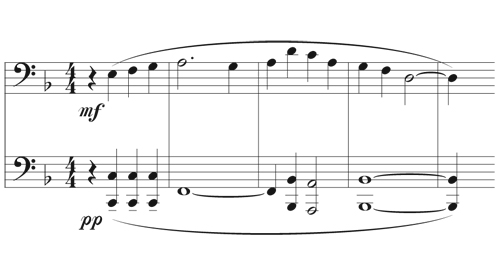
Learning the pitch tendencies of intervals, how to eliminate beats, the characteristic tendencies of instruments, and when to use alternate fingerings and shadings takes considerable patience and diligence, but over time, it will greatly accelerate perfecting intonation in rehearsals. All efforts toward teaching intonation must serve the higher purpose of making beautiful music.






